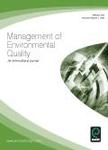版权所有:内蒙古大学图书馆 技术提供:维普资讯• 智图
内蒙古自治区呼和浩特市赛罕区大学西街235号 邮编: 010021

作者机构:De La Salle Univ Chem Engn Dept Manila Philippines De La Salle Univ Sch Econ Manila Philippines
出 版 物:《MANAGEMENT OF ENVIRONMENTAL QUALITY》 (环境质量管理)
年 卷 期:2018年第29卷第1期
页 面:63-75页
学科分类:12[管理学] 120202[管理学-企业管理(含:财务管理、市场营销、人力资源管理)] 0202[经济学-应用经济学] 02[经济学] 0830[工学-环境科学与工程(可授工学、理学、农学学位)] 1202[管理学-工商管理] 1201[管理学-管理科学与工程(可授管理学、工学学位)]
主 题:Water footprint Optimization Input-output model Virtual water Water resource management
摘 要:Purpose - The onset of climate change is expected to result in variations in weather patterns which can exacerbate water scarcity issues. This can potentially impact the economic productivity of nations as economic activities are highly dependent on water especially for agricultural countries. In response to this, the concepts of virtual water and water footprint have been introduced as metrics for measuring the water intensity of products, services and nations. Researchers have thus looked into virtual water trade flows as a potential strategy for alleviating water scarcity. The paper aims to discuss these issues. Design/methodology/approach - Environmentally extended input-output models (IOMs) are often used to analyze interactions between economic and ecological systems. This work thus develops a multi-regional input-output model for optimizing virtual water trade between different geographic regions in consideration of local environmental resource constraints, product demands and economic productivity. Findings - A case study on agriculture crop production and trade in different regions of the Philippines is utilized to demonstrate the capabilities of the model. The results show that the optimal strategy does not necessarily limit a water-scarce region to produce less water-intensive crops. Research limitations/implications - The model uses an input-output framework whose fixed coefficients reflect a fixed technological state. As such, the model is best used for short-term projections, or projections for mature technological state (i.e. where no major gains in efficiency or yield can be foreseen). Practical implications - The proposed modeling framework can be used in any geographic region (provided relevant statistical data are available for calibration) to provide decision support for optimal use of limited water resources. Originality/value - The model proposed in this work has general applicability to the optimal planning of agro-industrial systems under wat